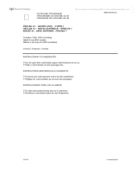The poet describes the Garden of Gesthemane and the betrayal of Christ. In his typical manner, he presents the scene from the perspective of a participant engaging in an act of recollection rather than as an authority who has merely learned about an event at second hand ("After the torchlight red on sweaty faces").
The poet "remembers" an episode along the road to Emmaus when the resurrected Christ may have appeared to him and his fellow disciples as a hooded and mysterious figure. This was also stimulated by the account of one of the Antarctic expeditions, it was related that the party of explorers, at the extremity of their strength, had the constant delusion that there was one more member than could actually be counted. It is significant that the poet/disciple does not recognize Christ when he appears ("Who is the third who walks beside you?”). The theme of the poem is the absence of spiritual consolation. As the poet continues to degenerate mentally, the associations within his poem become increasingly incoherent and complex.
In the poet’s imagination, the road to Emmaus becomes combined with the image of a highway leading out of the war-ravaged territories of Eastern Europe. The poet confuses the sound of airplanes overhead with the cries of mothers who have lost their children ("murmur of maternal lamentation"). The imagery of the poem becomes hallucinogenic and apocalyptic, suggesting mutation, disorder, and hopeless despair ("bats with baby faces, ... crawled head downward down a broken wall").
Standing before a ruined cathedral (perhaps a bomb site left over from the war), the poet concludes that he is at the gates of the Castle Perilous, where the questing knights of Arthurian legend prepared to approach to the Holy Grail. The Chapel Perilous in the Grail legend is a mysterious and deadly place where the hero knight meets with a strange and terrifying adventure. Sometimes there is a dead body laid on the altar, sometimes a black hand extinguishes the tapers. There are threatening voices, and throughout evil and supernatural forces engaged. But the chapel has been destroyed. It is a "decayed hole among the mountains."
As thunder echoes overhead, the poet imagines that he hears the voice of God telling him what he must do to find the Holy Grail ("Then spoke the thunder").The thunder seems to announce the traditional Hindu/Buddhist/Christian injunction against surrendering to the senses and ignoring the spiritual dimension of human life. The thunder commands the poet to "give of himself," to "sympathize with others," and to "control his passions."
As the poet fades into madness, he struggles to find in his poetry some source of order that might satisfy his desire for religious conviction. ("These fragments I have shored against my ruins.") But he disintegrates emotionally before he has the opportunity to reflect upon the message of the thunder or to arrive at spiritual insight. Ironically, the poet’s last lines, "shantih, shantih, shantih" (which translate roughly as "the peace that surpasses understanding") are, by the end of his poem, the incoherent ravings of a lunatic rather expressions of the wisdom the poet has been struggling to achieve. The poet finds peace by losing himself to madness rather than by finding peace in God.
The poem ends with the exposition of three terms from Hindu lore: Datta (to give alms), Dayadhvam (to have compassion), and Damyata (to practice self-control). Then the poem seems to collapse into a rush of quotations and allusions-- a flood of meanings and suggestions ending with the word shanti (peace). The final stanza of "once again link Western and Eastern traditions, transporting the reader to the Ganges and the Himalayas, and then returning to the Thames and London Bridge. Eliot’s tactic throughout his poem has been that of eclecticism, of mixing and matching and of diversity, and here this strain reaches a culmination. The relevant Upanishad passage, which Eliot quotes, describes God delivering three groups of followers -– men, demons, and the gods -– the sound “Da.” The challenge is to pull some meaning out of this apparently meaningless syllable. For men, “Da” becomes “Datta,” meaning to give; this order is meant to curb man’s greed. For demons, “dayadhvam” is the dictum: these cruel and sadistic beings must show compassion and empathy for others. Finally, the gods must learn control – “damyata” – for they are wild and rebellious. Together, these three orders add up to a consistent moral perspective, composure, generosity, and empathy lying at the core.







